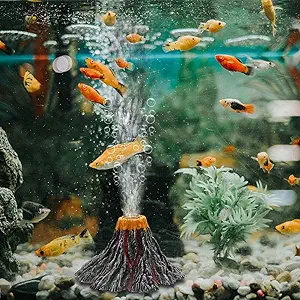Introduction
Axolotls are fascinating amphibians that require a well-thought-out aquarium setup to thrive. Unlike typical pet fish, axolotls have specific requirements when it comes to tank size, water conditions, and decor. If you’re planning to bring home an axolotl, this detailed guide will help you set up the perfect habitat to keep your aquatic pet healthy and happy.
Why Proper Aquarium Setup is Crucial for Axolotls
Setting up a proper aquarium for your axolotl is essential because:
- Axolotls are sensitive to poor water conditions.
- They require a specific temperature range.
- Their delicate skin can be damaged by sharp decorations.
- They need plenty of space to move around comfortably.
A well-maintained tank ensures your axolotl remains stress-free and lives a long, healthy life.
Choosing the Right Tank for Your Axolotl
Tank Size and Dimensions
Axolotls need ample space to move around freely. A 20-gallon (75 liters) tank is the minimum recommended size for a single axolotl. However, a 30-40 gallon (113-150 liters) tank is ideal, especially if you plan on adding more axolotls in the future.
Key Tank Requirements:
- Tank Width: Axolotls prefer horizontal space rather than vertical height.
- Secure Lid: Axolotls can jump, so a covered tank is necessary.
- Bare Bottom vs. Substrate: Bare-bottom tanks are easier to clean, but fine sand is a safer choice than gravel, which can cause impaction if ingested.
Water Conditions and Filtration
Water Temperature
Axolotls thrive in cool water. The ideal temperature range is 60-68°F (16-20°C). Water temperatures above 72°F (22°C) can cause stress, illness, and even death.
Tips for Maintaining Temperature:
- Use a chiller or a fan if your home gets too warm.
- Keep the tank away from direct sunlight and heat sources.
Water Quality and Parameters
Axolotls are highly sensitive to water quality. The following parameters should be maintained:
- pH Level: 6.5 – 8.0
- Ammonia & Nitrites: 0 ppm (toxic at any level)
- Nitrates: Below 20 ppm
- Hardness: Moderate to hard water preferred
Filtration System
A good filtration system helps maintain water quality and reduces maintenance efforts.
Best Filter Options:
- Sponge Filters: Gentle on axolotls, ideal for biological filtration.
- Hang-on-Back Filters: Provide good filtration but need a flow-reduction system.
- Canister Filters: Best for larger tanks but must be adjusted to prevent strong currents.
Tip: Axolotls do not like strong water currents, so always use a low-flow filter or a spray bar to diffuse water movement.
Tank Setup and Decoration
Substrate Selection
- Best Option: Fine sand – It is safe and mimics their natural habitat.
- Avoid: Gravel and pebbles – Axolotls may accidentally swallow them, leading to impaction.
Hiding Spots and Decor
Axolotls need plenty of hiding spots to reduce stress. You can add:
- Caves and PVC pipes – Provide secure resting areas.
- Driftwood and large smooth rocks – Make sure they have no sharp edges.
- Live or artificial plants – Offer shade and hiding spaces.
Lighting Requirements
Axolotls are nocturnal and do not require bright lighting. If you choose to use lights, opt for low-intensity LED lights and ensure plenty of shaded areas.
Setting Up Your Axolotl Tank Step by Step
- Select the Tank: Choose a 20-gallon or larger aquarium.
- Add the Substrate: Use fine sand or a bare-bottom setup.
- Install the Filter: Use a sponge, HOB, or canister filter with low flow.
- Fill the Tank: Use dechlorinated water.
- Set Up the Decorations: Add caves, plants, and hiding spots.
- Cycle the Tank: Establish beneficial bacteria (takes 4-6 weeks).
- Maintain the Temperature: Keep water between 60-68°F (16-20°C).
- Monitor Water Quality: Test regularly for ammonia, nitrites, and nitrates.
- Introduce Your Axolotl: After cycling, slowly acclimate your axolotl to the tank.
Feeding and Maintenance
Also Read:
Diet and Feeding Schedule
Axolotls are carnivores and thrive on a high-protein diet. Their diet includes:
- Live Foods: Earthworms, bloodworms, daphnia
- Pellets: High-quality axolotl pellets
- Frozen Foods: Brine shrimp, blackworms
Feeding Guidelines:
- Juveniles: Feed daily
- Adults: Feed 2-3 times per week
- Remove uneaten food after 15-30 minutes
Tank Maintenance Routine
To keep the tank clean and water parameters stable:
- Perform Weekly Water Changes: 20-30% water change every week.
- Remove Waste Daily: Use a turkey baster or siphon.
- Monitor Water Quality: Test weekly with an aquarium test kit.
- Clean the Filter: Rinse filter media in tank water (never tap water).
Common Problems and Solutions
Cloudy Water
- Cause: Bacteria bloom or excess food.
- Solution: Reduce feeding, increase filtration, perform water changes.
Floating Axolotl
- Cause: Air bubbles, constipation, or stress.
- Solution: Adjust diet, ensure correct water parameters.
Fungal Infections
- Cause: Poor water quality, injuries.
- Solution: Improve water quality, use salt baths or antifungal treatments.
Conclusion
Setting up an axolotl aquarium requires careful planning and regular maintenance. By following the guidelines in this article, you can create a thriving environment for your axolotl. Ensure proper tank size, filtration, and water conditions to keep your axolotl healthy and happy.
Do you have any questions or personal experiences with axolotl tanks? Let us know in the comments below!


















Add comment